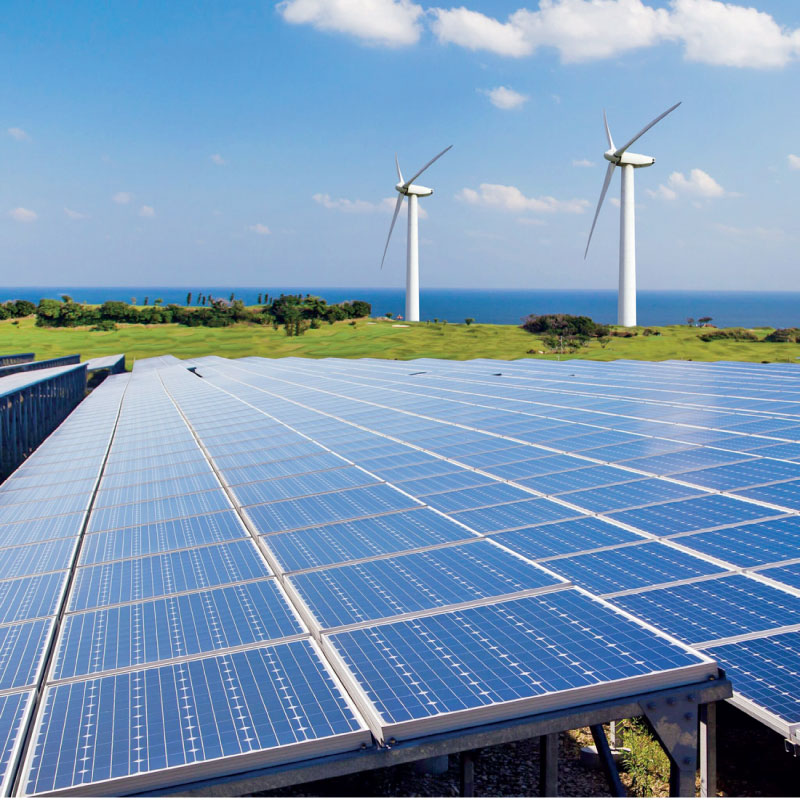Monday Apr 21, 2025
Monday Apr 21, 2025
Monday, 21 April 2025 00:00 - - {{hitsCtrl.values.hits}}

A balance of RE with traditional sources like hydro, thermal and gas is required to ensure system stability
 The Government is going ahead with the CEB restructure process quickly and the Cabinet has reportedly signed off on the new Bill. As one of the contributors to this process by way of comments, the writer is moderately happy with the way the process has been handled and its progress. Ideally, more consultation should have happened, but considering the importance placed on the price of electricity in the Government’s industrialisation agenda, and the IMF and local critics looking with eagle eyes, the hurry to get on with it is understandable and criticism is not fair.
The Government is going ahead with the CEB restructure process quickly and the Cabinet has reportedly signed off on the new Bill. As one of the contributors to this process by way of comments, the writer is moderately happy with the way the process has been handled and its progress. Ideally, more consultation should have happened, but considering the importance placed on the price of electricity in the Government’s industrialisation agenda, and the IMF and local critics looking with eagle eyes, the hurry to get on with it is understandable and criticism is not fair.
Looks like a restructured CEB is going to be in place before the end of this year. In January 2025, the Regulator (PUCSL) handed down its determination on electricity pricing for the first six months of the year. Electricity prices were substantially reduced and things were going well until the 9 February blackout. Since then, CEB has been under fire about the fallout from the blackout and the subsequent speculation about an impending reduction in prices for ‘feed in tariffs’ for renewable energy.
This article aims to highlight some of the misconceptions and misreporting about the role of renewables in the electricity system, system stability concerns, electricity tariffs, profitability and the structural transformation required to make the electricity system ‘fit for purpose’.
Why is the CEB under fire?
CEB has not convinced the public about the real reasons for the 9 February blackout. Few reports have emerged and statements heard that contradict and confuse the public. This appears to be a cultural issue with the CEB, as we have seen a similar pattern in the past, when several such blackouts had occurred since 2009. However, even with the advent of a new Government with a positive change of governance culture, the same behaviour seems to be repeated. Hopefully, the sooner the restructure comes, the sooner we can see cultural and behavioural change.
CEB has been blamed for impending reduced feed in tariffs for renewable energy, for new installations. However, this is not of CEB’s making and is in realty, being discussed by the Government. In the past weeks the renewables industry has been making a lot of noise citing unfair treatment, involvement of mafias, impending financial losses and speculation that SL may not meet its own RE targets by 2030. Let’s try to understand the underlying reasons for these criticisms.
Are these criticisms justifiable?
With regard to the blackout, indications are that it was clearly avoidable. There are many possible reasons, but these have not been transparently articulated. In advanced countries, a utility has its own specialist unit which is strictly independent of formal organisation hierarchy that investigate such incidents, make recommendations and ensure that those recommendations are implemented over an agreed timeframe. In addition, there is also a Safety Regulator who has the statutory powers to investigate, report and if required, prosecute the utility or its personnel, depending on the severity of the incident. There are instances when specialist private investigators may also be called in to investigate and report. All this is done to make sure that the occurrence of such incidents is minimised or eliminated altogether. This sort of safety culture is required to be brought into practice in SL.
Ironically, some learned persons have said that the cause of the failure was natural. It was not. International best practice is that industry standards coupled with risk management reduces the probability of such incidents appreciably. Even if the initial safety barrier had failed, the power system must have protective systems to operate and prevent a catastrophic failure of the type experienced. These are some of the fundaments that have to be learnt and addressed to prevent such failures in the future. Misconceptions about the basics provide an “its ok” type of attitude that is bad and unacceptable in today’s world.
Then there was also the issue of high penetration of solar energy on a Sunday, when the power system was lightly loaded, which was attributed to, as a possible cause. Many views on this have been heard, and it may well have, if the preceding safety barriers mentioned above had failed prior. That is why, as mentioned before, a proper independent investigation is required to establish the facts and these must be communicated clearly to the public, to instil confidence in the system.
Renewable energy penetration issues
Regarding the use of intermittent RE (solar and wind) on a large scale, a balance of RE with traditional sources like hydro, thermal and gas is required to ensure system stability. ‘RE with batteries’ allow more RE to be added to maintain the required system stability but the cost of batteries, particularly the larger utility scale batteries, are expensive. Even in Australia batteries are being progressively added after careful planning, due to their cost and the need to manage overall electricity production costs. Traditional sources like coal and gas are still extensively used in Australia to maintain system balance, coal being phased out gradually, with more gas plants being introduced.
For SL, utility scale batteries are a luxury with the scarcity of foreign currency and is possible only with soft loans from the likes of ADB. One good thing to come out from the 9 February blackout is that policy makers are now taking more interest in the battery solution as a way of keeping the people’s appetite high for rooftop solar and other types of intermittent RE systems, thereby saving on the Government investing taxpayer funds for new power generation.
It will be good for the Government (not CEB) to give some thought to providing rebates for homeowners with rooftop solar to install batteries. Considering that the Government’s CAPEX budget is Rs. 1.4 trillion this year and if all of it can’t be spent in the limited time period, there is definitely an investment opportunity here. Those who don’t currently have solar will not be disadvantaged, as without such incentives, everyone is affected if taxpayer funded batteries are sourced for utility scale application.
The Australian general election is in May and the ruling Labour party is offering an AUD 4k rebate to households with rooftop solar to install a battery. The typical price of a battery being around AUD 12k, the payback period works out to around 7+ years. The opposition Liberal Party is proposing Nuclear as an option. These examples are useful in understanding the ‘RE versus conventional energy systems’ debate, which exists in many democratic countries. Hence, it is naïve to label people who back conventional energy systems and their need for maintaining system stability, as people associated with some mafia. This is ridiculous. Moreover, now there is a Government with new ideas and new laws that will enable the scrutiny of various types of unfair business advantages that some enjoyed in the past, which might make the word ‘mafia’ associated with energy, redundant in SL soon.
 It will be good for the Government (not CEB) to give some thought to providing rebates for homeowners with rooftop solar to install batteries. Considering that the Government’s CAPEX budget is Rs. 1.4 trillion this year and if all of it can’t be spent in the limited time period, there is definitely an investment opportunity here. Those who don’t currently have solar will not be disadvantaged, as without such incentives, everyone is affected if taxpayer funded batteries are sourced for utility scale application
It will be good for the Government (not CEB) to give some thought to providing rebates for homeowners with rooftop solar to install batteries. Considering that the Government’s CAPEX budget is Rs. 1.4 trillion this year and if all of it can’t be spent in the limited time period, there is definitely an investment opportunity here. Those who don’t currently have solar will not be disadvantaged, as without such incentives, everyone is affected if taxpayer funded batteries are sourced for utility scale application
The challenge for CEB management
The Regulator (PUCSL) has set cost targets for the CEB and fixed price of electricity sold to consumer groups, for the first six months in 2025. Although the unit cost is about Rs. 7 higher than the average price in simple terms, when multiplied by the estimated number of electricity units to be consumed, the total cost balances out with the total revenue, when the savings from 2024 are carried over. So, the CEB ledger should be in balance by end-June, provided it can meet the unit cost target set by the PUCSL. This is the challenge for CEB management, as the Government policy set before the elections was clear in that the high end SOEs like CEB need to achieve given KPI targets.
Electricity consumers wait with bated breath for PUCSL’s next price setting post June 2025. Power generation cost pressures internally and the adverse effects on the economy from Trump tariffs externally, will certainly play a role, noting that the tariff for industrial consumers and hotels is currently set very low, much lower than even Bangladesh, Pakistan, India, Vietnam and Cambodia, who are supposed to be some of our competitors for FDI.
What next for CEB and the Government
CEB and the Government are trying hard to get new solar and wind generation at the least unit cost, which must be applauded. In this context, it is also logical to pay a reasonably comparable price for rooftop solar and other RE sourced at a micro level. In other countries too households install rooftop solar for two main reasons; do the right thing by the environment and enjoy the benefit of reducing their bills after a reasonable payback period. The writer has also personally done so for the same reasons and not looking at it as a business. For those investing in RE as a business, or industries that install solar on their rooftops, the usual investment cost and returns must apply and it is logical that incentives for those cohorts are considered separately from incentives provided for household rooftop solar.
The CEB power systems need lots of physical and technological upgrades to absorb more RE, which requires capital investment which is problematic with the current economic climate. The writer sees that it is inevitable that private capital has to be attracted not only for power generation, and this needs serious consideration in the restructure of the CEB. How this capital is obtained is a matter for the Reform Secretariat and the Government, but people must realise that this is the only way if an electricity system that is reliable, affordable and of good quality is to be established in SL, keeping ideological considerations aside.
(The writer is an electrical engineer with over 25 years’ experience in Australian electricity networks as a Manager and a Principal Engineer. He also worked as a Safety Regulator in establishing and enforcing safety regulations and investigating electricity network incidents. He worked as an electrical engineer at CEB, in the first 10 years of his career. He could be contacted at [email protected].)